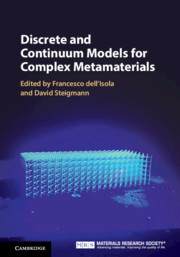Book contents
- Frontmatter
- Contents
- List of Contributors
- Part I Designing Complex (Meta)Materials: Results and Perspectives
- Part II Mathematical and Numerical Methods
- 4 Naive Model Theory: Its Applications to the Theory of Metamaterials Design
- 5 Lagrangian Discrete Models: Applications to Metamaterials
- 6 Experimental Methods in Pantographic Structures
- 7 Variational Methods as Versatile Tools in Multidisciplinary Modeling and Computation
- 8 Least Action and Virtual Work Principles for the Formulation of Generalized Continuum Models
- Index
5 - Lagrangian Discrete Models: Applications to Metamaterials
from Part II - Mathematical and Numerical Methods
Published online by Cambridge University Press: 20 February 2020
- Frontmatter
- Contents
- List of Contributors
- Part I Designing Complex (Meta)Materials: Results and Perspectives
- Part II Mathematical and Numerical Methods
- 4 Naive Model Theory: Its Applications to the Theory of Metamaterials Design
- 5 Lagrangian Discrete Models: Applications to Metamaterials
- 6 Experimental Methods in Pantographic Structures
- 7 Variational Methods as Versatile Tools in Multidisciplinary Modeling and Computation
- 8 Least Action and Virtual Work Principles for the Formulation of Generalized Continuum Models
- Index
Summary
Lagrangian discrete models are the most ancient and still most effective models used in mechanics to predict the behavior of complex systems. Their structure is presented here, in a very classical way, which follows the classical presentation given by Levi-Civita. Their flexibility is highlighted, together with their capacity to be used in very efficient numerical codes. They must be regarded as a preferred tool also in the formulation of problems in the theory of metamaterials.
Information
- Type
- Chapter
- Information
- Discrete and Continuum Models for Complex Metamaterials , pp. 197 - 262Publisher: Cambridge University PressPrint publication year: 2020
Accessibility standard: Unknown
Why this information is here
This section outlines the accessibility features of this content - including support for screen readers, full keyboard navigation and high-contrast display options. This may not be relevant for you.Accessibility Information
- 4
- Cited by
